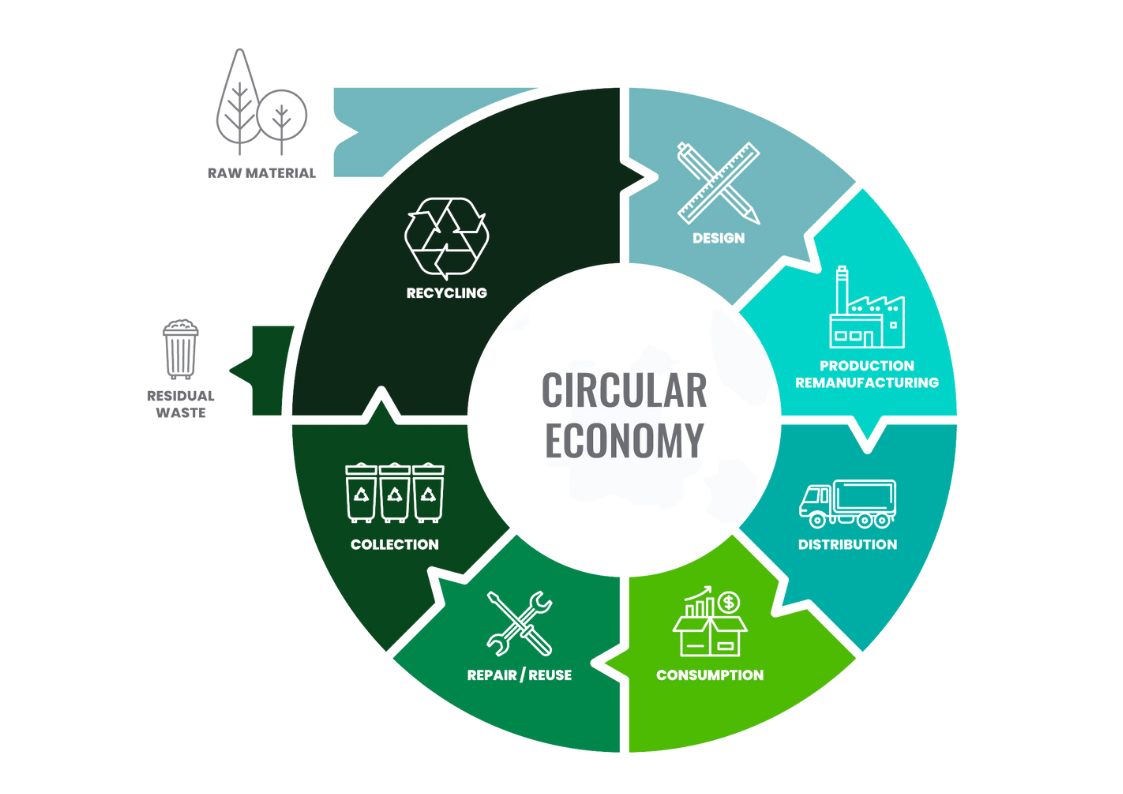The world is grappling with an escalating pollution crisis, with adverse effects on our environment, health, and well-being. In this era of rapid industrialization and mass consumption, traditional linear economic models have led to the unsustainable extraction of finite resources and waste disposal in landfills, oceans, and the atmosphere. To address these pressing issues, the circular economy concept has gained prominence as a viable and sustainable alternative. This article will explore how the circular economy can play an essential role in solving the pollution crisis.
Understanding the Circular Economy
The circular economy is designed to minimize waste and make the most of resources. It shifts from the linear “take, make, dispose” model to one emphasizing three fundamental principles: reduce, reuse, and recycle. These principles drive the entire lifecycle of products, materials, and resources, promoting sustainability, environmental responsibility, and economic growth.
Resource Efficiency and Pollution Reduction
One of the primary ways the circular economy helps combat the pollution crisis is by promoting resource efficiency. Traditional linear production methods are highly resource-intensive, relying on large quantities of raw materials and much energy. As a result, industries have contributed significantly to pollution and resource depletion.
In contrast, the circular economy seeks to extract maximum value from resources through practices such as product design for longevity, materials recycling, and the sharing economy. This approach minimizes pollution at its source by maximizing the lifespan of products and reducing waste generation. For example, products designed with durability are less likely to end up in landfills, reducing the pollution associated with waste disposal.
Minimizing Single-Use Plastics
Single-use plastics have become a symbol of environmental degradation and pollution. These items, often discarded after a single use, clog our oceans, harm wildlife, and persist in the environment for centuries. Circular economy strategies tackle this issue head-on by advocating for plastic reduction, reuse, and recycling.
The circular economy seeks to minimize the production and consumption of single-use plastics by implementing reusable packaging, material substitution, and closed-loop recycling systems. These strategies reduce pollution and conserve valuable resources that would otherwise be used to create new plastic products.
The Importance of Recycling
Recycling plays a central role in the circular economy’s pollution-fighting arsenal. Traditional linear systems often prioritize the extraction of raw materials over recycling, leading to resource depletion and increased pollution. The circular economy, however, promotes recycling as a cornerstone of sustainable resource management.
By establishing efficient recycling infrastructure and processes, the circular economy reduces the need for extracting new resources and decreases the pollution associated with resource extraction. Recycling also minimizes the energy required to create products from raw materials, reducing pollution.
Sustainable Consumption
Consumer behavior significantly influences pollution levels. In a linear economy, consumers are encouraged to discard and replace products frequently, contributing to a culture of overconsumption and waste. The circular economy, on the other hand, promotes sustainable consumption patterns.
Through initiatives like product leasing, repair services, and sharing platforms, the circular economy encourages consumers to make the most of their belongings, reducing the demand for new products and, consequently, pollution associated with manufacturing and disposal.
Green Innovation and Job Creation
Transitioning to a circular economy needs innovation in product design, manufacturing processes, and supply chains. This drive for innovation helps reduce pollution and creates new job opportunities in industries focused on sustainability and environmental responsibility.
Circular economy practices often lead to the development of cleaner technologies and greener alternatives, contributing to reduced emissions and less pollution. Moreover, the shift towards circularity can stimulate economic growth by fostering entrepreneurship and driving investments in sustainable industries.
Circular Economy in Action
Several real-world examples illustrate the effectiveness of the circular economy in addressing pollution:
Fashion Industry: The fashion industry is notorious for its environmental impact, including pollution from textile production and waste from discarded clothing. Circular fashion initiatives promote clothing rental, second-hand markets, and innovative recycling methods to minimize pollution and resource use.
Electronics Recycling: Electronics contain valuable and often hazardous materials. Circular economy models for electronics emphasize recycling and refurbishment to recover useful components while properly disposing of hazardous substances, preventing pollution.
Sustainable Agriculture: Circular agriculture practices focus on regenerative farming techniques, reducing chemical use, soil degradation, and water pollution. By imitating natural ecosystems, circular agriculture aims to maintain ecological balance and reduce the environmental impact of farming.
Final Thoughts: Challenges and Future Prospects
While the circular economy holds great promise in solving the pollution crisis, several challenges must be addressed for its widespread adoption. These challenges include changing consumer behavior, ensuring regulatory support, developing efficient recycling infrastructure, and promoting sustainable product design.
Governments, businesses, and individuals must actively participate in the transition to a circular economy to secure a cleaner and more sustainable future. Policymakers can enact regulations that incentivize circular practices, while businesses can integrate circularity into their supply chains and product design. Consumers can also contribute by prioritizing sustainable and circular products and services.
